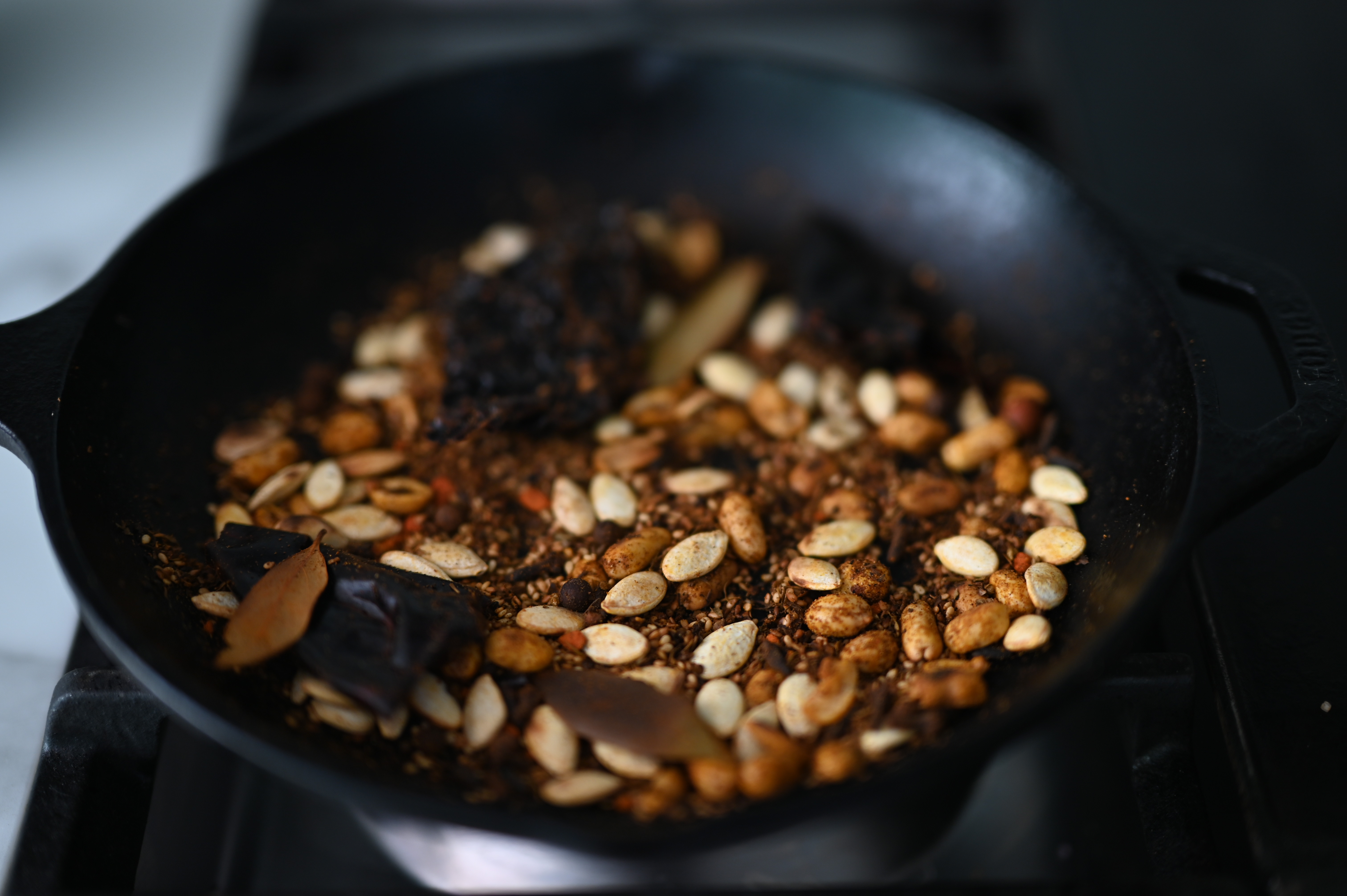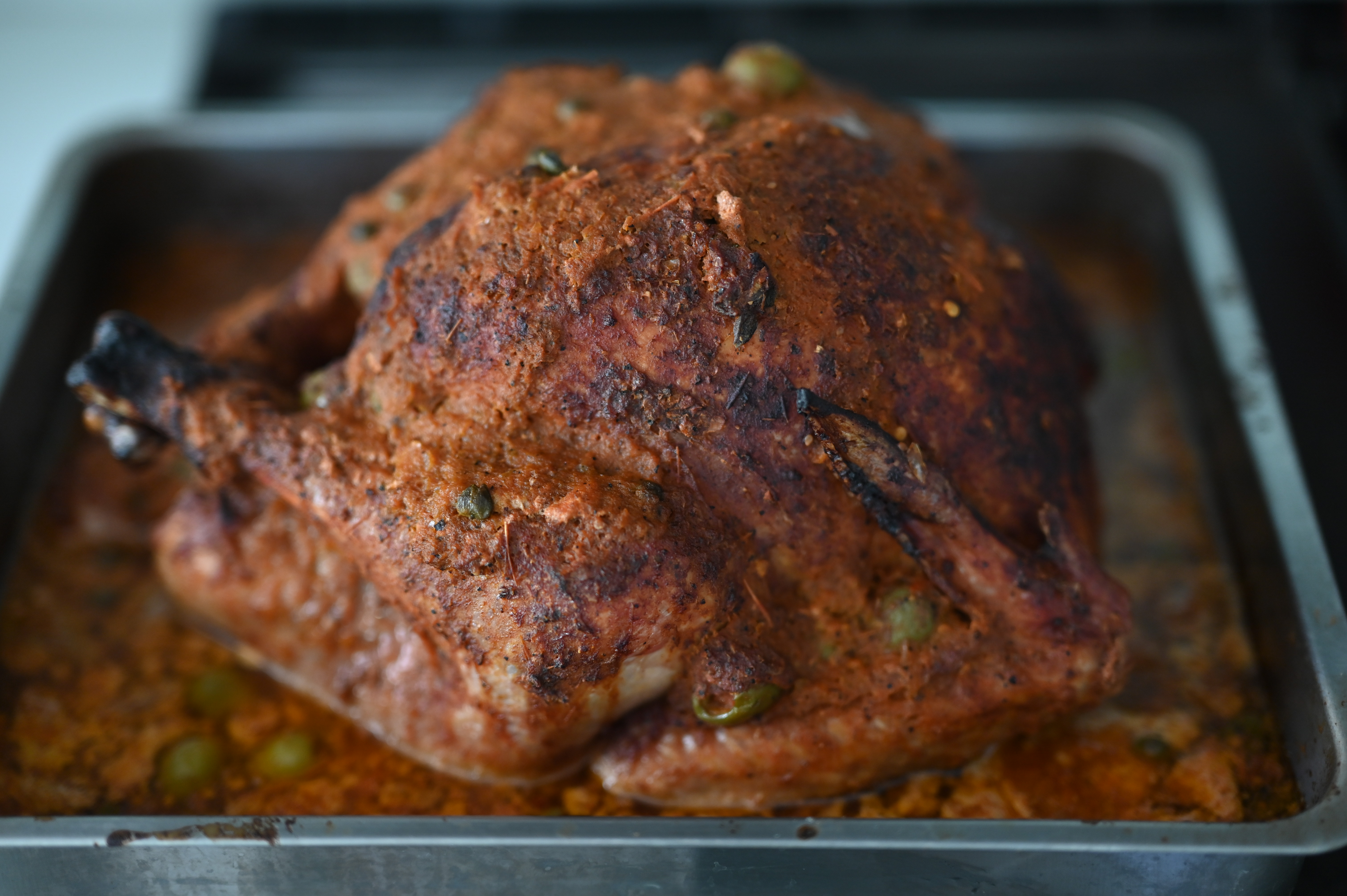
This turkey deserves to be on the hall of fame of holiday turkey recipes. It fills my childhood memories with the laughter and joy of the holidays. We make it either for Thanksgiving or Christmas, and we eat it with rice and salad or in sandwiches more traditionally known as panes con chumpe. The same sauce can be used with chicken to make panes con pollo. Find some really good French style bread. Spread some mayo, add lettuce, tomatoes, watercress, and a succulent piece of turkey or chicken, dripping with this delicious sauce.
You will need:
- 1 turkey, about 16 lbs., thawed, cleaned, and legs tied trussed together. *Baking time will vary depending on the weight of your turkey.
- 1 onion
- 1 bunch of fresh thyme & oregano
*Advice: Trussing the legs is optional. If do, make sure to use a thermometer to check for doneness. Not trussing allows the sauce to fill the cavity of the turkey making both the sauce and turkey more flavorful. What I do is remove the trussing the last hour of baking to allow the juices to flow in the cavity much better. Add the giblets and neck to the sauce. The neck can be cooked alongside the turkey. It adds flavor to the sauce.
Marinade & Rub:
- ½ cup butter, softened
- 2 garlic cloves, mashed
- 2 tablespoons mustard
- 1 teaspoon salt
- 1 teaspoon ground pepper
- 1 cup white wine (reserve, see instructions below)
Sauce:
- 15 Roma tomatoes
- 1 onion, peeled and cut in quarters
- 3 green bell peppers, seeded and quartered (or chopped in large pieces)
- 1 red bell pepper, seeded and quartered
- 2 garlic cloves, crushed and peeled
- 2 cups chicken broth
- 1 carrot
- 1 celery stick
- 1 5.5 oz. jar pimento stuffed Spanish olives, drained
- 1 2.5 oz. jar capers, drained
Spice mix for the sauce (a.k.a. Relajo):
- 2 tablespoons pumpkin seeds
- 2 tablespoons sesame seeds
- 1/2 teaspoon whole cloves
- 3 bay leaves
- 1 tablespoon oregano
- 1 dried guajillo chile, seeded
- 1 dried pasilla or ancho chile, seeded
- 1 tablespoon whole allspice
- 2 tablespoons peanuts, unsalted
- 1 teaspoon dried thyme
- 1 teaspoon ground cumin
- 1 teaspoon ground achiote or paprika

To marinate the turkey:
Mix marinade & rub ingredients, except the wine, into a paste. Rub the turkey with this paste. Place the turkey in a large baking dish and pour the wine all over the turkey. Cover tightly and allow it to marinate in the fridge overnight.
To make the sauce:
Brush a skillet or grill with a little oil and grill the tomatoes whole, along with the onions and bell peppers. Set aside.
Cook the carrot and celery in some chicken stock. Reserve this cooking liquid to thin out the sauce.
Next, toast all the spices until they’re slightly brown and the aroma fills your entire kitchen. Toasting the spices helps to intensify and release all the flavors.
Blend the tomatoes, onion, 2 garlic cloves, bell peppers and toasted spices. *You may have to work in batches. Add chicken stock to thin out the sauce. Season with salt and pepper to taste. You can also add a pinch of sugar to cut the tartness of the tomatoes. Cook on low-medium heat for 30 minutes, stirring occasionally. Add whole jars of olives and capers, including a bit of the brine. Keep warm as you will be basting your turkey with this sauce.


To roast the turkey:
Preheat the oven to 325-350°F on convection mode. Place the turkey breast side up along with the marinade liquid in the roasting pan. Stuff the onion and fresh herbs into the cavity.
After the first hour of baking, begin basting the turkey every 30 minutes with its own juices from the bottom of the pan as well as some tomato sauce, one ladleful at a time. Bake for 3-4 more hours.
Advice: Switch to regular bake mode during the last hour if you would like to speed up the cooking time. Convection mode is usually for slower roasting, but the end result will be a more tender and juice bird, with a crispy skin.
*Testing doneness with a thermometer is highly recommended.
Because this is a very tender and saucy turkey, it must be left in the roasting pan when carving & serving.








En Español
Nadie más cocina el pavo como nosotros. No hay necesidad de bañar la pechuga reseca con salsa de gravy, a menos que te guste el gravy. No más pavo seco. Este pavo sale jugoso y suculento, y la carne se cae de los huesos. Es rostizado y luego cocido en una salsa a base de tomate que está llena de sabor y especias. Este pavo se merece estar en el Salón de la Fama de las recetas de pavo. Llena mis recuerdos de mi infancia con la risa y la alegría de las fiestas navideña. Ahora, como vivimos en Estados Unidos, mi mamá lo cocina ya sea para el Día de Acción de Gracias o Navidad y lo comemos con arroz y ensalada o en sándwiches más tradicionalmente conocidos como panes con chumpe. La misma salsa se puede utilizar con pollos para hacer panes con pollo, los cuales se hacen con pan estilo francés, mayonesa, lechuga, tomate, berro y un suculento pedazo de pavo o pollo, que chorrea con esta deliciosa salsa. Es para chuparse los dedos.
Pavo Navideño
Necesitará:
1 pavo, cerca de 16 lbs. , descongelado, limpio, y con las piernas atadas
Puede atar las piernas del pavo con hilo de cocina, pero esto es opcional. Mi mamá se salta este paso a veces y el pavo resulta bien. Permite que la salsa llene la cavidad del pavo haciendo tanto la salsa y el pavo más gustoso. Guarde las menudencias y el cuello para hacer un caldo o salsa después. El cuello se puede hornear al lado del pavo.
Marinada y adobo:
- ½ taza de mantequilla, derretida
- 2 dientes de ajo, hechos puré
- 2 cucharadas de mostaza
- 1 cucharadita de sal
- 1 cucharadita de pimienta molida
- 1 taza de vino blanco
Salsa:
- 15 tomates Roma
- 1 cebolla, pelada y cortada en cuartos
- 3 chiles verdes, sin semillas y en cuartos (o picados en trozos grandes)
- 1 chile rojo, sin semillas y en cuartos
- 2 dientes de ajo, pelados y machacados
- 2 tazas de caldo de pollo
- 1 tarro de 5.5 oz de aceitunas españolas rellenas de pimiento, escurridas
- 1 tarro de 2.5 oz de alcaparras, escurridas
Mezcla de especias para la salsa (en El Salvador se le conoce como relajo):
- 2 cucharadas de semillas de calabaza (pepitorias)
- 2 cucharadas de semillas de sésamo (ajonjolí)
- 1/2 cucharadita de clavos de olor
- 3 hojas de laurel
- 1 cucharada de orégano
- 1 chile guaque o guajillo seco, sin semillas
- 1 chile ciruela o pasilla seco, sin semillas
- 1 cucharada de pimienta inglesa entera (pimienta gorda)
- 2 cucharadas de cacahuetes, sin sal
- 1 cucharadita de tomillo seco
- 1 cucharadita de comino molido
- 1 cucharadita de achiote molido o pimentón
Para marinar el pavo:
Mezcle los ingredientes de la marinada y el adobo, excepto el vino, hasta formar una pasta. Frote el pavo con esta pasta. Coloque el pavo en una fuente para horno grande o una bolsa zip lock y verter el vino en todo el pavo. Cubra bien y deje que se marine en la nevera toda la noche.
Para hacer la salsa:
Frote una sartén o cacerola con un poco de aceite y ase los tomates junto con las cebollas y los chiles. Póngalos a un lado.
A continuación, en la misma sartén aceitada, tueste todas las especias hasta que estén ligeramente doradas y el aroma llene toda su cocina. Tostar las especias ayuda a intensificar todos los sabores.
Licúe los tomates, la cebolla, 2 dientes de ajo, los pimientos y, todas las especias. *Es posible que tenga licuar por pocos y añadir caldo de pollo para diluir la salsa, aproximadamente 2 tazas.
Vierta la salsa de tomate en una olla grande. Sazone con sal y pimienta al gusto. También se le puede agregar una pizca de azúcar para reducir la acidez de los tomates. Cocine sobre fuego medio-bajo durante 30 minutos, revolviendo ocasionalmente.
Para hornear el pavo:
Precaliente el horno a 350°F. Coloque el pavo con la pechuga hacia abajo junto con la marinada en una fuente para hornear, pero no sobre una rejilla. Hornear durante 3-4 horas, dando vuelta el pavo cada hora para rostizar todos los lados de manera uniforme. Mojar el pavo cada 30 minutos con sus propios jugos de la parte inferior de la fuente y también con un poco de salsa de tomate. Vierta las aceitunas y las alcaparras escurridas sobre el pavo y en la salsa en la fuente para hornear durante la última hora de cocción . Si las patas y las alas se están rostizando demasiado rápido, cúbralas con papel de aluminio para protegerlas del calor y continuar horneando el pavo. Debido a que este es un pavo muy blando y jugoso, debe dejarse en la fuente para hornear al servir. Puede desmoronarse si se intenta poner todo en una bandeja.

Thanks for quoting me and the credits. Nice article. Love it.
LikeLike
Thank you so much for the beautiful recipe! I was wondering if the mustard is prepared mustard or dry mustard. Thank you!
Susan
LikeLike
Hello =) It is regular mustard like what you’d put on hot dogs.
LikeLike